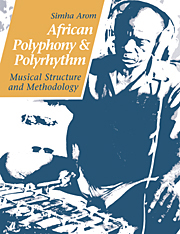Book contents
- Frontmatter
- Contents
- List of illustrations
- Foreword by György Ligeti
- Preface
- Acknowledgements
- BOOK I THE MUSIC OF THE CENTRAL AFRICAN REPUBLIC
- BOOK II AFRICAN POLYPHONIC MUSIC
- BOOK III TECHNICAL TOOLS: METHODS OF RECORDING POLYPHONIC MUSIC FOR TRANSCRIPTION
- 1 The need for transcription
- 2 The difficulties of transcription
- 3 Earlier methods
- 4 Towards a new method
- 5 Theoretical assumptions
- 6 Technical equipment: description and use
- 7 From recording to transcription
- 8 Checking the results
- 9 Potentialities
- 10 Anthropological validity
- BOOK IV THEORETICAL TOOLS
- BOOK V THE ORGANISATION OF TIME IN AFRICAN MUSIC
- BOOK VI STRUCTURAL PRINCIPLES AND THEIR APPLICATION
- Conclusion
- Bibliography
9 - Potentialities
Published online by Cambridge University Press: 27 January 2010
- Frontmatter
- Contents
- List of illustrations
- Foreword by György Ligeti
- Preface
- Acknowledgements
- BOOK I THE MUSIC OF THE CENTRAL AFRICAN REPUBLIC
- BOOK II AFRICAN POLYPHONIC MUSIC
- BOOK III TECHNICAL TOOLS: METHODS OF RECORDING POLYPHONIC MUSIC FOR TRANSCRIPTION
- 1 The need for transcription
- 2 The difficulties of transcription
- 3 Earlier methods
- 4 Towards a new method
- 5 Theoretical assumptions
- 6 Technical equipment: description and use
- 7 From recording to transcription
- 8 Checking the results
- 9 Potentialities
- 10 Anthropological validity
- BOOK IV THEORETICAL TOOLS
- BOOK V THE ORGANISATION OF TIME IN AFRICAN MUSIC
- BOOK VI STRUCTURAL PRINCIPLES AND THEIR APPLICATION
- Conclusion
- Bibliography
Summary
The method described can be used to decompose polyphony into a coherent set of elementary monodies. It is therefore the first method to be devised which is capable of providing students of musicology, acoustics, and organology with a recording of the individual parts in any piece. It thereby makes it possible to conduct laboratory studies which were previously restricted to monodic music: pitch analysis, decomposition of the frequency spectrum by real-time analysis, sonographic studies of harmonics and overtones, and melographic recordings of melodic curves. It also constitutes a new tool for ethnomusicological research into the musical psychology of peoples with orally transmitted polyphonic traditions, particularly, into how far the musicians consciously develop their polyphony and what individual limits are placed on their musical ‘productivity’. A few of these possibilities will now be illustrated by specific examples.
We wanted to find out to what extent each of the singers in a group of Pygmies was conscious of the polyphonic structure of a specific piece, i.e., of its metric, rhythmic, modal, and vertical, i.e., ‘harmonic’, organisation. After recording the first singer in the traditional order of entry, we asked each of the remaining performers to develop a counterpoint to the melody of this initial ‘cantus firmus’. This was done by about ten people. We found that, despite (or perhaps because of) the experimental conditions, all were perfectly clear about how the metre, rhythm, mode, and vertical organisation of their parts should be directly related to the ‘cantus firmus’.
Conversely, it is impossible, by merely listening, to determine how Pygmy vocal polyphony is organised, despite the obviously coherent relationships among the undeterminable number of voices.
- Type
- Chapter
- Information
- African Polyphony and PolyrhythmMusical Structure and Methodology, pp. 115 - 117Publisher: Cambridge University PressPrint publication year: 1991

